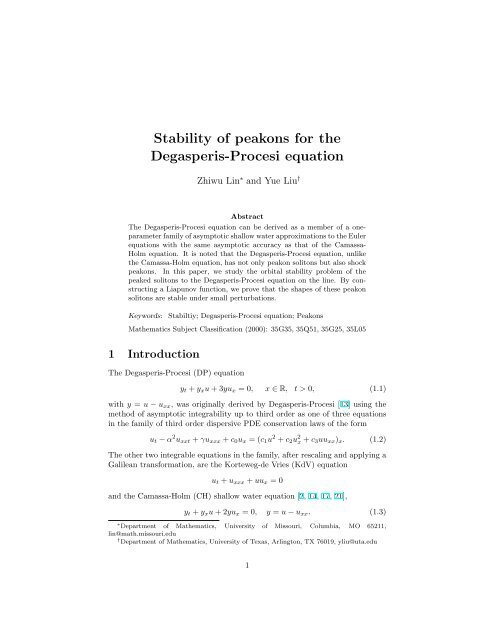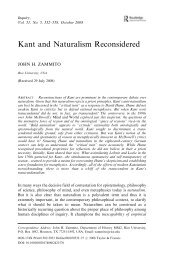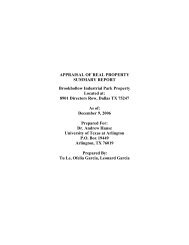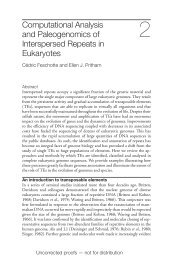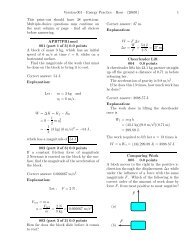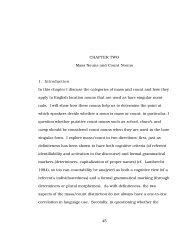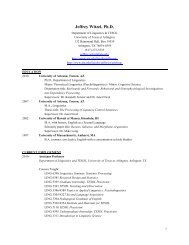Stability of Peakons for the Degasperis-Procesi Equation
Stability of Peakons for the Degasperis-Procesi Equation
Stability of Peakons for the Degasperis-Procesi Equation
You also want an ePaper? Increase the reach of your titles
YUMPU automatically turns print PDFs into web optimized ePapers that Google loves.
<strong>Stability</strong> <strong>of</strong> peakons <strong>for</strong> <strong>the</strong><br />
<strong>Degasperis</strong>-<strong>Procesi</strong> equation<br />
Zhiwu Lin ∗ and Yue Liu †<br />
Abstract<br />
The <strong>Degasperis</strong>-<strong>Procesi</strong> equation can be derived as a member <strong>of</strong> a oneparameter<br />
family <strong>of</strong> asymptotic shallow water approximations to <strong>the</strong> Euler<br />
equations with <strong>the</strong> same asymptotic accuracy as that <strong>of</strong> <strong>the</strong> Camassa-<br />
Holm equation. It is noted that <strong>the</strong> <strong>Degasperis</strong>-<strong>Procesi</strong> equation, unlike<br />
<strong>the</strong> Camassa-Holm equation, has not only peakon solitons but also shock<br />
peakons. In this paper, we study <strong>the</strong> orbital stability problem <strong>of</strong> <strong>the</strong><br />
peaked solitons to <strong>the</strong> <strong>Degasperis</strong>-<strong>Procesi</strong> equation on <strong>the</strong> line. By constructing<br />
a Liapunov function, we prove that <strong>the</strong> shapes <strong>of</strong> <strong>the</strong>se peakon<br />
solitons are stable under small perturbations.<br />
Keywords:<br />
Stabiltiy; <strong>Degasperis</strong>-<strong>Procesi</strong> equation; <strong>Peakons</strong><br />
Ma<strong>the</strong>matics Subject Classification (2000): 35G35, 35Q51, 35G25, 35L05<br />
1 Introduction<br />
The <strong>Degasperis</strong>-<strong>Procesi</strong> (DP) equation<br />
y t + y x u + 3yu x = 0, x ∈ R, t > 0, (1.1)<br />
with y = u − u xx , was originally derived by <strong>Degasperis</strong>-<strong>Procesi</strong> [13] using <strong>the</strong><br />
method <strong>of</strong> asymptotic integrability up to third order as one <strong>of</strong> three equations<br />
in <strong>the</strong> family <strong>of</strong> third order dispersive PDE conservation laws <strong>of</strong> <strong>the</strong> <strong>for</strong>m<br />
u t − α 2 u xxt + γu xxx + c 0 u x = (c 1 u 2 + c 2 u 2 x + c 3 uu xx ) x . (1.2)<br />
The o<strong>the</strong>r two integrable equations in <strong>the</strong> family, after rescaling and applying a<br />
Galilean trans<strong>for</strong>mation, are <strong>the</strong> Korteweg-de Vries (KdV) equation<br />
u t + u xxx + uu x = 0<br />
and <strong>the</strong> Camassa-Holm (CH) shallow water equation [2, 14, 17, 21],<br />
y t + y x u + 2yu x = 0, y = u − u xx . (1.3)<br />
∗ Department <strong>of</strong> Ma<strong>the</strong>matics, University <strong>of</strong> Missouri, Columbia, MO 65211,<br />
lin@math.missouri.edu<br />
† Department <strong>of</strong> Ma<strong>the</strong>matics, University <strong>of</strong> Texas, Arlington, TX 76019, yliu@uta.edu<br />
1


